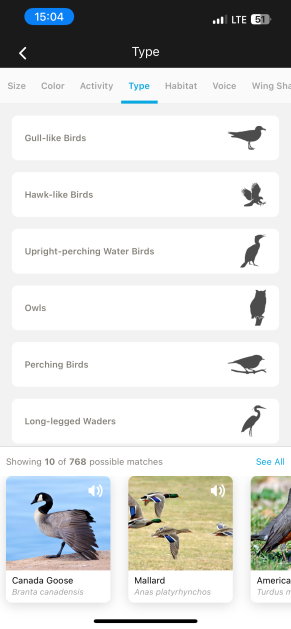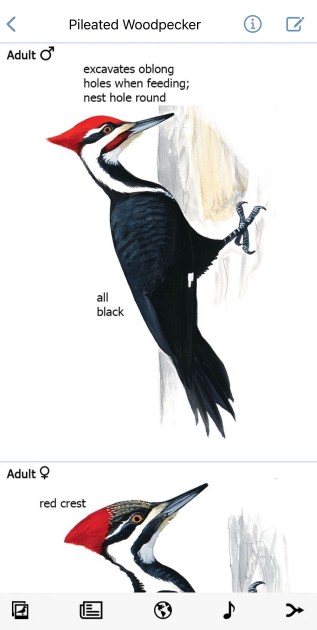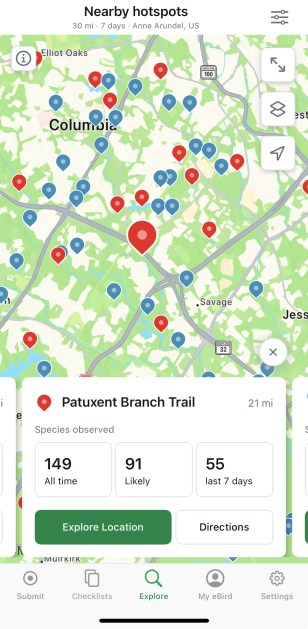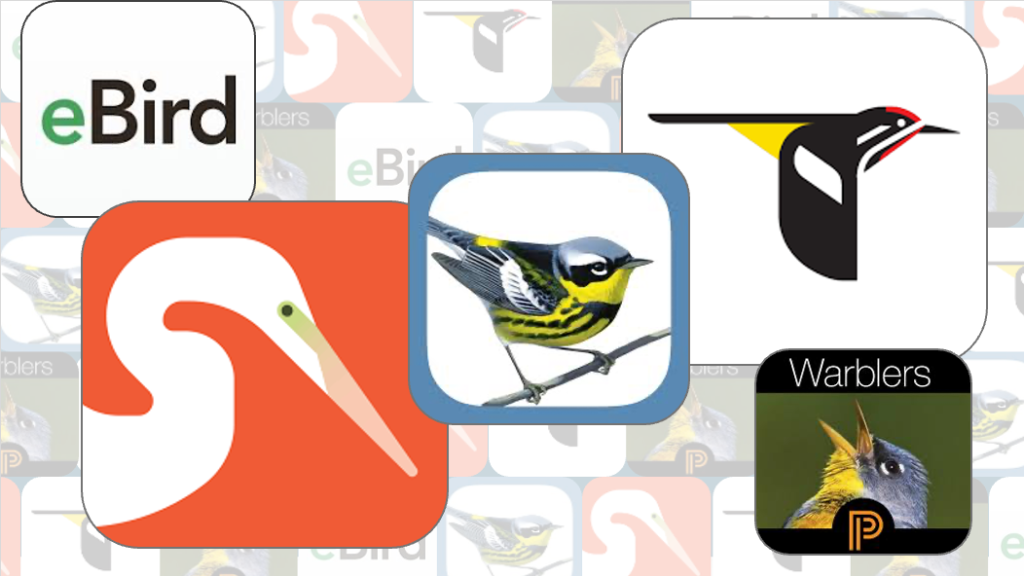For many people, birding is frustrating for any number of reasons. But the most common complaint we hear is: it’s really hard to match the bird I saw in my yard or at the beach or on a hike with the seemingly endless choices of birds in field guides.
Apps like Merlin, Audubon and others mentioned here help narrow that often frustrating gap between curiosity and knowledge. Many of these apps do the hard work of winnowing a list of “most-likelies” for you. For many birders (not just beginners), having one of these apps on your phone or tablet is like having an expert birding guide by your side at all times.
Become a Member
Making a Lasting Impact for Nature when you join The Nature Conservancy
Even better, it’s an expert birder and guide who doesn’t get annoyed when you ask the same questions over and over, or fail to identify an American robin by its song for the thousandth time. In fact, many people (including us) have more than one of these apps on our phones. Some of us might even have dedicated sections on their phones just for birding apps, but that’s a whole other post.
So whether you’re bird-curious and just starting out, want to build your birding skills, contribute to science, find places to bird, join communities of other birders, or all of the above, these apps are the ones we use ourselves and recommend the most.
Apps for Enjoying Birding (and Becoming a Better Birder)
Top 10 List
-
Merlin Bird ID
Cornell Lab of Ornithology

Since step one of becoming a better birder (aka enjoying birding) is learning to ID birds with accuracy and confidence, Merlin (powered by e-Bird) is my most recommended birding app for beginner to intermediate birders. (And most experts I know keep Merlin handy on their phones as well.)
From the app’s main page, you start with three choices for identifying a bird: step-by-step, sound, or photo. I find myself using the Sound Identification tool more than the others. Hear a bird? (Or many birds?) Hit the microphone icon right in the app, and Merlin will populate a list with the bird(s) most likely to be making the sounds you’re hearing.

This is the screen that shows on an iPhone when you first open the App. For me, it’s incredibly helpful when there are many birds singing and calling. Suddenly, it’s not an overwhelming cacophony, it’s an opportunity to improve my bird-by-ear skills. You can watch the list populate in real time, and as Merlin identifies individual bird songs and calls, it will highlight a picture of the bird most likely to be making it.
You can also go through an easy step-by-step interface focused on your location, date, and the field marks of the bird(s) you’re trying to identify (size, main colors, what the bird was doing), and it will again populate a list with images and links to songs and calls.
The app offers multiple ways to identify a bird with a very simple interface that is easy to learn and use. It’s also very mobile-friendly and can be used even when you’re away from wifi or cellular coverage.
If you can only have one birding app on your phone, Merlin is my best recommendation. It hits that sweet spot between ease of use, speed, accuracy, reference images and data, and sheer breadth of species and geographies.
For Merlin, it’s all about the “bird packs.” When you download the app, you can choose bird packs based on geography and download relevant packs. If you travel, Merlin is easy to take on the road and has excellent (and constantly improving) global coverage. Depending on how you enable your location permissions, you can select your location, or Merlin can auto-populate your location and date (you need to confirm), which can be helpful if you don’t want to have to enter that information every time you’re identifying a bird. (CCB)
Price: Free
Strengths: Bird identification (step-by-step, sound, photo); keeping a sighting list; contributing to science through its interface with e-bird (free account through Cornell Lab of Ornithology required to use with e-Bird); global coverage (with some exceptions). Supports multiple languages.
Works without wifi/cell coverage: Yes, if you download the birdpacks to your phone, Merlin works even if you’re away from wifi. (I recently tested the sound function in a Guatemalan cloud forest near Lake Atitlan. No cell signal and worked beautifully or I would have missed a crested guan. Sound ID also identified a Mexican whipoorwill that sadly remains on my heard but not seen list.)
Updates: The folks at Cornell Lab of Ornithology keep Merlin very up-to-date with regular additions and creations of new “bird packs” for different geographies. (Justine is waiting impatiently for Australia.)
-
Audubon
National Audubon Society

The National Audubon Society’s birding app is powered by more than 100 years of North American birding history (and e-Bird). It’s also incrediby beginner-friendly. Like Merlin, there is a step-by-step identification tool that offers filters for narrowing down the list of most-likelies of nearby birds. Unlike Merlin, the Audubon App currently supports only North American species.
But if you want an app to help you systematically build your field-based birding skills, I’m not sure there’s a better option than Audubon. One of its great strengths is that the app offers a variety of excellent identification filters. I find myself scrolling through the filters even when I’m not out birding because they’re great tutorials on the foundational elements of bird identification. Using the Audubon app has improved my observation skills by improving the parts of a bird I reflexive look for based on what information I need to populate the filters.

Screenshot from the Audubon App. In addition to color, size and activity, the app also lets users filter by tail shape, wing shape, habitat, voice, and something Audubon calls “type.” Selecting “type” sends you to a page to choose from options, including “Gull-Like birds,” “Upright-Perching Water Birds,” “Owls”, and (my personal favorite), “Chicken-Like Marsh Birds.” (That filter was invaluable when I was trying to rapidly differentiate between gallinules). “Type” is helpful (especially for beginners) because if you’re unfamiliar with bird taxonomies and how they’re grouped, being able to look at a section called “Long-legged waders” instead of having to sort through storks, cranes, herons, ibis and allies builds confidence and enjoyment. (At least for me).
A note about the “Voice” filter as well. When I first started birding, the expert birders I tagged along with would often describe the bird sounds we were hearing as a “chirp or a chip,” a “buzz,” “trill,” “twitter,” or “warble” and I would nod along like I knew what they were talking about. One of the challenges of learning to bird by ear is that individual birds have a variety of different vocalizations, knowing the difference between a “trill” and a “buzz” helps you rapidly narrow potential species. The Voice filter lets you listen to the different sounds and put a name to what you’re hearing.
The Audubon App offers a variety of different ways to use the filters and you can choose which filters are most useful (or available) to you on any given sighting. It also offers an “Explore” section (powered by e-bird) that, with a click of an icon, will show you (depending on how you set up your location permissions) local hotspots and sightings).
You can use the bird identification features of the Audubon app without signing up for an account (free). But, if you want to keep your sighting list, share sightings, or have access to all of the app’s features, you’ll need to set one up.
Price: Free
Strengths: Bird identification (robust, structured filters); keeping a sighting list; contributing to science through its interface with e-Bird (free account through Cornell Lab of Ornithology required to use with e-Bird); wealth of “featured content” within the app itself so you can scroll the app for additional content even when you’re not actively birding.
Works without wifi/cell coverage: Yes. You’ll need to download the field guide when you install the app, but after that, it works without wifi or cell coverage. (I tested it in the Everglades and it worked great.)
Updates: Audubon keeps the app updated and regularly adds new features.
-
Sibley Birds (v2)
David Sibley | My Digital Earth

The Sibley Guide to Birds is my absolute favorite North American field guide. (Sorry Peterson fans, but I’ll die on this hill). And so it’s no surprise that the app version is my go-to ID source when I’m trying to travel light.
The app’s design is straightforward and will be familiar to anyone who has ever used an app-base field guide. You can filter your results by location (state) and time of year (month), which is a handy way to avoid checking individual range maps. You can sort species by alpha-order or taxonomic order, and then wither scroll or swipe form one bird to the next.

Screenshot The Sibley apps standout features are its illustrations. Author David Sibley is among the world’s best bird illustrators, and he has an uncanny ability to capture a species’ typical posture and movement in a static image. Also helpful are the accessory illustrations, which depict birds in flight or in the midst of other key behaviors. The app also benefits from a robust library of bird calls and accurate range maps.
Another useful feature works similar to Merlin’s ID questionnaire. Answer a few basic questions about any bird you saw (general type, size, color, pattern, behavior) and the app will pull a list of possible species. Between the two I’d probably choose Merlin for this particular functionality, but I’m also such a fan of illustrative guides (versus photos) that I always consult Sibley on tricky IDs.
Price: $19.99 USD
Strengths: Bird identification (Sibley is the best illustrative guide on the market); quick-glance rarity status for your location; and bird call recordings
Works without wifi/cell coverage: Yes. The entire app is functional even if you’re far beyond the reach of wifi or cell service.
Updates: This app is based on the 2018 Sibley Guide to Birds hardcover field guide. Since its release, the Sibley team have pushed two major updates to incorporate new species, new audio files, and some additional search functionality. The last of those updates was December 2019.
-
The Warbler Guide
By Tom Stephenson & Scott Whittle | Princeton University Press

The 2013 Warbler Guide is hands-down one of the best birding field guides ever made. Comprehensive and well-designed, it’s the field guide to rule all field guides, at least when it comes to identifying the 35+ warbler species in North America. It remains one of my most treasured guides, despite the fact that I now live more than 6,000 miles from the nearest New World warbler.
The book’s only flaw? It’s size. Like many of the best wildlife guides, it has enough heft to be used as a weapon. Hence the brilliance and value of the Warbler Guide app, released alongside the book in 2013. I now use the print version as a desk reference, and the app when I’m traveling back to North America to get my fill of warblery goodness.

Like the book, what sets this app apart from the pack is its exceptional design and tight focus on the particulars of warbler ID. The navigation menu lets you quickly sort by season, general location, and view (side, face, underside, etc). You can also navigate the full list of species — either taxonomic or alphabetic — or group warblers by their predominant color. The app also features 3D models of birds in all plumages, which you can rotate and pinch-zoomable to match field experience of a bird
So if you catch a glimpse of a black-and-white warbler belly while you’re birding in Florida in May, you can filter the app to display those results within seconds. And those seconds matter with warblers, which (if you’re like me) are usually seen for a fleeting second, in poor light, and you’re not quite sure if that was a blackpoll or a black-and-white or an ovenbird.
Another exceptional feature: The prominent display of similar species, viewed from the same angle. The app also features an extensive collections of songs, chip calls, and flight calls for all species, along with annotated sonograms (for the visual learners among us) showing song structure and key ID points. For those who really want to nerd out, the app also has a comprehensive photo library to help determine the age and sex of each species.
If you’re feeling intimidated by the wealth of data packed down into a single app, don’t be. The Warbler Guide website features helpful tutorials on how to make the most of the app. (JEH)
Price: $12.99 USD
Strengths: Warbler identification from every angle (including fleeting, undertail-covert views); 3D models of birds in all plumages; full song & call library, including sonograms
Works without wifi/cell coverage: Yes. The entire app is functional even if you’re far beyond the reach of wifi or cell service.
Updates: This app is designed as a digital equivalent to the 2013 Warbler Guide print book. So aside from any major taxonomic shake-ups, there’s no need for regular updates.
-
e-Bird
Cornell Lab of Ornithology (with founding partner Audubon)

We put e-Bird last in this list because it’s both an app in and of itself and a companion to other apps. Unlike the Merlin and Audubon apps, it does require you to set up an account (free) with the Cornell Lab of Ornithology.
Quick note: You don’t have to have an e-Bird account to use the Merlin or Audubon mobile apps, but adding e-Bird to your repertoire opens up, as the app says, a new world of birding. The e-Bird mobile app integrates with both Merlin and Audubon, but it’s not built for aiding individual bird identification, per se, the way the other two apps are. e-Bird is built for science.
When you integrate e-Bird into your birding journey by using it to track your bird sightings (whether on hikes or in your own neighborhood) and then submitting your sighting lists, you’re contributing to science that informs bird conservation around the world. That said, e-Bird is built for anyone with an interest in birds, from the newly bird-curious to hard core birders with thousands of species on their lifelists.

The e-Bird Mobile app is really the gateway to the wider e-Bird site. To get the most out of e-Bird, you need to spend some time with the app on a computer, but it’s more than worth the time to climb the learning curve. Fortuntely, the site offers excellent tutorials (check out the free e-Bird essentials video course) so you can be sure your sightings are as clean and accurate as possible from a data perspective. You can also dive into the wealth of information within your e-Bird online account. (e-Bird also supports multiple languages).
If you’re a list and / or data person, you will love e-Bird’s powerful dashboard. It tracks sightings, archives your submitted photos and recordings, and is easy to sort and manipulate in a variety of ways: want to sort by species? or location? or taxonomy? e-Bird has you covered.

Depending on how you want to manage your data privacy preferences (there are robust privacy tools and a very clear FAQ section that outlines how e-Bird does and does not use your data), there is a strong community aspect to e-Bird. You can share your sightings as part of the “world’s largest birding community,” see leading birders in your area (or around the world), find local hotspots, sign up for e-bird species alerts, and other emails on locations or bird topics you care about.
I use the hotspot feature both at home and when I travel to see who is seeing what and where. I also use it in my own county to keep track of species for my life list, though I’m a little haphazard about list keeping. Which brings me to a true birding confession: I am not a list person. I’ve tried to be, but I’m just not. If there is anything that might change that, it’s e-Bird.
Fortunately, depending on your particular interests, e-Bird can be either a banquet or a buffet and you can choose how much you want to partake.
I enjoy submitting sighting lists to e-Bird and tracking what I’ve seen, but I usually only do it with species I see in my yard, when I travel, or if I’m out specifically to bird. I am not what anyone would call a diligent e-Birder / list keeper. But with e-Bird, I can choose my own adventure and so can you. As the app says, every sighting counts. I have found though that the more I use e-Bird, the more I enjoy it so maybe e-Bird will make a diligent list keeper out of me yet. (CCB)




Join the Discussion